 |
 |
Performance reporting model : Diagram
> OUTPUT GROUP 1:
Broadcast and Transcription Services
1.1 Broadcast Production
OUTPUT GROUP 2:
Support and Technology Services
2.1 Infrastructure
OUTPUT GROUP 1:
BROADCAST AND TRANSCRIPTION SERVICES
OUTPUT 1.1 BROADCAST PRODUCTION
Broadcasting produces live radio and television coverage of the Senate, the House of Representatives, the Main Committee of the House of Representatives, public hearings of parliamentary committees and special events held in Parliament House.
At the output group level, Broadcasting measures performance against indicators of quantity, price and quality.
Broadcast quantity
Television and radio coverage of the House of Representatives, the Senate and parliamentary committees is provided to all occupants of Parliament House. It is also provided to the community through:
- live television and radio feeds to media bureaux in Parliament House
- live webcasting on the Parliament's Internet site (www.aph.gov.au)
- live webcasting on the ABC's Public Record Internet site
- live radio broadcasting of one House each sitting day by ABC radio's Parliamentary and News Network (PNN)
- ABC television and SkyNews subscription television both broadcasting Question Times
- the Intra-government Communications Network in Canberra which provides live television coverage to 32 government organisations
- the TransACT subscription service in Canberra.
The following performance results were achieved while undertaking a major multi-skilling
program across Broadcasting to make more effective use of staff skills and to
reduce the need for staff to work unacceptably long hours. Broadcasting accommodation
underwent major office refurbishment and temporary relocation, which was achieved
with minimal disruption.
Performance indicator: Number of hours broadcast, by category.
Basis for comparison: Trends over time.
Chambers
Hours Broadcast (Television and Audio) - Chambers

1460 hours of chamber proceedings were broadcast (television and audio) in 2002-2003. This reflected a significant increase over 2001-2002, due to the 2001 election, but was consistent with comparable non-election years.
200203 Hours Broadcast (Television and Audio) - Chambers

While the workload over each quarter was relatively consistent, increased Main Committee sittings continued to stretch broadcasting resources, particularly during concurrent sittings of Senate Estimates committees and the House of Representatives and when the sittings of the Main Committee were scheduled with little, or very late, notice.
Committees
Hours Broadcast (Television and Audio) - Committees
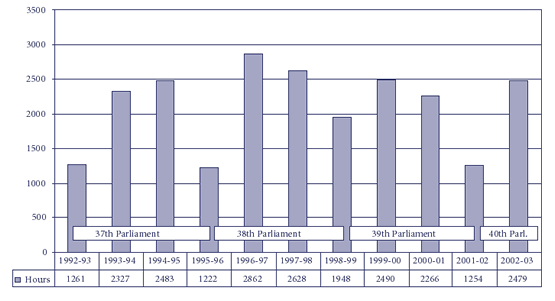
2479 hours of committee hearings were broadcast (television and audio) in 2002-2003. This reflected a significant increase over 2001-2002, due to the 2001 election, although the total hours was comparable with previous non-election years.
200203 Hours Broadcast (Television and Audio) - Committees
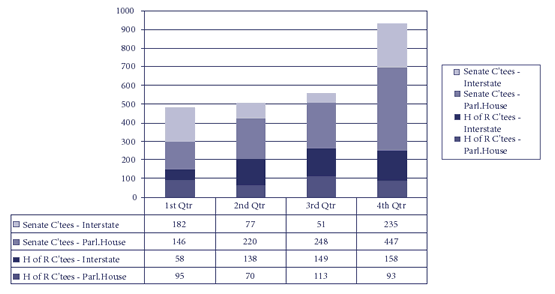
While the overall broadcasting workload from committees was static in the first three quarters of 2002-2003, the significant fourth quarter workload from Senate committees, including both interstate and Parliament House hearings, presented resource management challenges.
Client specific broadcast services
Client Specific Broadcast Services
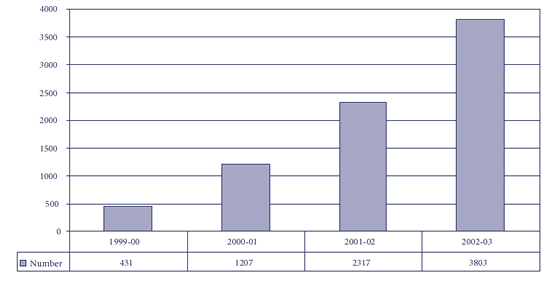
The number of client specific broadcast services rose significantly during 2002-2003 to 3803 compared to 2317 in 2001-2002. In the four years 1999-2000 to 2002-2003, there was a 782 per cent increase in these services which amounted to an average of 100 hours of activity a week in 2002- 2003. Client specific broadcast services include filming pieces to camera, setting up and operating audio-visual equipment and completing videotape requests.
Broadcast price (cost)
Performance indicator: Direct and full cost per hour of broadcast, by category.
Basis for comparison: Trends over time.
Price (Cost) Per Hour of Broadcast
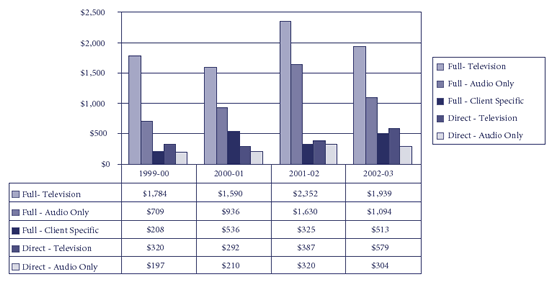
The overall cost of the Broadcasting output in 2002-2003 was $8.922 million, an increase of 10 per cent over 2001-2002 ($8.144 million).
The reduced full costs per hour of broadcast for both television and audio between 2001-2002 and 2002-2003 were due to the distribution of large fixed costs across a higher number of hours of both chambers and committees. The increased full costs for client specific broadcast services were due to the significant increase of direct activity hours required to provide the requested services.
The increased direct costs per hour of broadcast for television reflect the higher direct labour costs incurred between 2001-2002 and 2002-2003 in part attributed to additional staff rostered for training of new staff. The reduced direct costs per hour of broadcast for audio only between 2001-2002 and 2002-2003 are due to reductions in the levels of additional staff rostered for training since 2001-2002.
Broadcast quality
Performance indicator: Number of clients very satisfied or satisfied with services.
Basis for comparison: Trends over time.
Broadcasting Client Satisfaction Levels - Very Satisfied or Satisfied
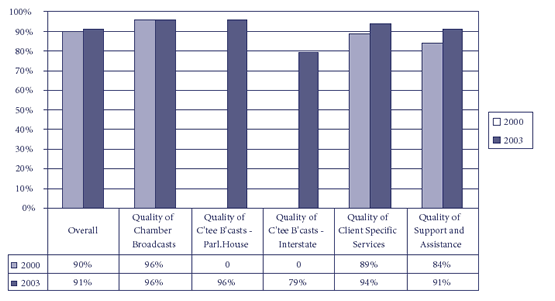
The DPRS 2003 Client Survey sought the views of Senators, Members and senior parliamentary staff regarding their levels of satisfaction with DPRS services. Of those surveyed, 91 per cent were either very satisfied or satisfied with broadcast services overall, an increase of one per cent on the DPRS 2000 Client Survey results. The only area in which clients suggested improvements was in audio services for interstate committee hearings. The broadcasting section will take account of client views and will ensure that clients are kept informed where it is not possible to replicate the services available in Parliament House.